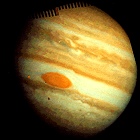 Rolled out in 1977 alongside other early cartridge-based systems as the Fairchild Channel F and Atari VCS, RCA’s Studio II heralded the entry of a TV/technology giant into the burgeoning video game landscape. To put it in context, RCA was a significant entity in American television and electronics in the 1970s: this was kind of like Sony deciding to launch a video game console. Only about ten years before, RCA had launched its first color television sets on the American market, and at the time, it also owned NBC. RCA funneled money into NBC’s coffers to ensure a flow of color (and colorful) programming to make the switch to color television an enticing one for the public, keeping such shows as Star Trek alive when ratings alone would’ve dictated swift cancellation. To put it succinctly, in the age before Japanese-made electronics dominated the market, RCA wielded a big stick. Surely, if RCA was wading into the video game market, it was going to be something major.
Rolled out in 1977 alongside other early cartridge-based systems as the Fairchild Channel F and Atari VCS, RCA’s Studio II heralded the entry of a TV/technology giant into the burgeoning video game landscape. To put it in context, RCA was a significant entity in American television and electronics in the 1970s: this was kind of like Sony deciding to launch a video game console. Only about ten years before, RCA had launched its first color television sets on the American market, and at the time, it also owned NBC. RCA funneled money into NBC’s coffers to ensure a flow of color (and colorful) programming to make the switch to color television an enticing one for the public, keeping such shows as Star Trek alive when ratings alone would’ve dictated swift cancellation. To put it succinctly, in the age before Japanese-made electronics dominated the market, RCA wielded a big stick. Surely, if RCA was wading into the video game market, it was going to be something major.
There’s just one problem: RCA misjudged its first video game console by a wide margin. Whether it was a development curve that failed to take the latest developments into account, or whether it was a complete misunderstanding of the market, the Studio II “home television programmer” seemed like a game machine that arrived late to the party. Its black & white graphics already marked it as a relic; Atari, Coleco and Magnavox had made the move to color with their respective Pong, Telstar and Odyssey lines already. Aside from not making the leap to color (a surprising move from a company that had used all of its influence to shoehorn color TV into the American living room a decade earlier), the graphics were barely graphics at all: big, blocky and clumsy. Control of the Studio II was achieved using two twelve-key keypads that couldn’t be removed from the base unit, forcing players to be virtually glued to the machine…which couldn’t be placed very far from the TV.
To put it mildly, most consumers probably expected much better from RCA, and Studio II’s disappointing sales reflected this. Barely a dozen games hit the market before RCA declared the project dead and left the video game market for good. Ironically, though, the processor at  the heart of the Studio II would find a niche in the world of space exploration. After Pioneers 10 and 11 swung past Jupiter in the early 1970s, nearly getting their electronic brains fried by the huge planet’s intense radiation, NASA was in the market for a radiation-resistant chip – and the COSMAC chip which drove the Studio II quickly became the chip of choice for spacecraft venturing into unfriendly environments. Radiation-hardened versions of the COSMAC chip used by Studio II flew on Voyagers 1 and 2 (which were also launched in 1977) and Galileo; given the spectacular results achieved by those robotic explorers, one has to imagine that their COSMAC chips were uprated versions as well…because their pictures of Jupiter didn’t look like they came out of a RCA Studio II.
the heart of the Studio II would find a niche in the world of space exploration. After Pioneers 10 and 11 swung past Jupiter in the early 1970s, nearly getting their electronic brains fried by the huge planet’s intense radiation, NASA was in the market for a radiation-resistant chip – and the COSMAC chip which drove the Studio II quickly became the chip of choice for spacecraft venturing into unfriendly environments. Radiation-hardened versions of the COSMAC chip used by Studio II flew on Voyagers 1 and 2 (which were also launched in 1977) and Galileo; given the spectacular results achieved by those robotic explorers, one has to imagine that their COSMAC chips were uprated versions as well…because their pictures of Jupiter didn’t look like they came out of a RCA Studio II.
[jwcatpostlist orderby=title order=asc includecats=446]
